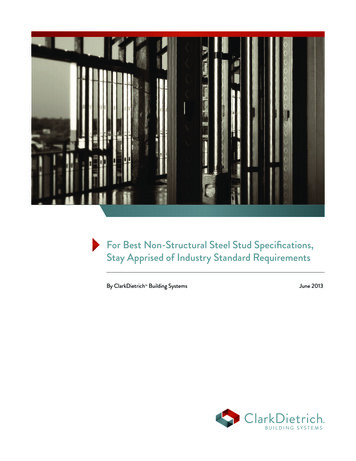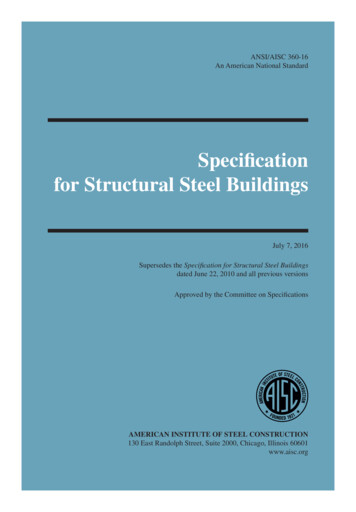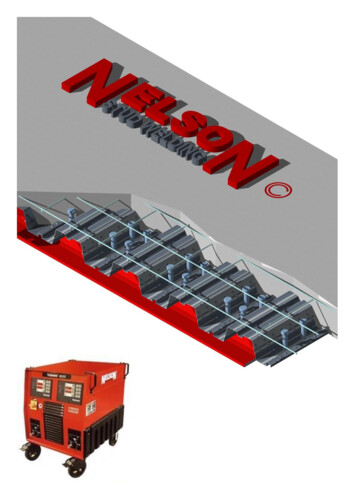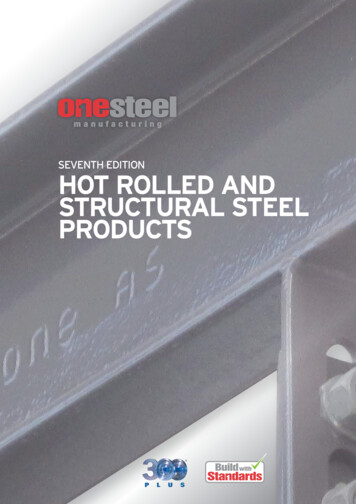
Transcription
For Best Non-Structural Steel Stud Specifications,Stay Apprised of Industry Standard RequirementsBy ClarkDietrich Building SystemsJune 2013
clarkdietrich.comFor Best Non-Structural Steel Stud Specifications,Stay Apprised of Industry Standard RequirementsBy ClarkDietrich Building SystemsWITH A HISTORY SPANNING MORE THAN HALF A CENTURY in noncombustiblecommercial construction, cold-formed steel is a popular material choice for framingnon-structural interior walls, load-bearing interior and exterior walls, floor joists, and curtainwalls. The many performance-based characteristics and green attributes of cold-formedsteel framing have enabled architects to design structures that are safer and more durable,dynamic as well as sustainable.Cold-formed steel offers the strength, durability and stability needed for framingapplications. From a sustainable construction standpoint, the material is ideal for newconstruction and commercial renovation projects. Unlike wood, it’s noncombustible,corrosion- and mold-resistant, termite-proof, made with high recycled content, reduceson-site construction waste, and can be recycled at the end of the structure’s life cycle.Cold-formed steel framing products are 100% recyclable, and can be locally or regionallysourced for most projects. In fact, new construction projects that feature cold-formedsteel components are eligible for up to 12 LEED points, collectively, from eightdifferent LEED credit categories.The two primary framing applications for cold-formed steel are structural and non-structural.This paper will focus on non-structural framing members and their installation. Non-structuralsteel studs are not designed for bearing any axial loads, and are ideal for supporting thedead load of many typical wall finishes, such as gypsum board, tile, etc., and providingresistance to limited interior transverse loads.N O N-S T R U C T U R A L S T E E L S T U D S P E C I F I C AT I O N S 2
clarkdietrich.comAccounting for the use of nearly 60 percent of all metal studs in the United States, interior,non-structural wall partitions are one of the most common applications for steel framing—specifically light-gauge steel studs. Therefore, it’s important to understand the materialand manufacturing requirements for light-gauge non-structural steel studs set byASTM C645, the installation requirements set by ASTM C754, and the specificationof fire-rated partitions.Regarding non-structural steel framing, the next thing to watch for is the emergence of thenew AISI standard, AISI S220: North American Standard for Cold-Formed Steel Framing—Non-Structural Members. This new standard has been adopted by the 2015 InternationalBuilding Code (IBC) and eventually will replace ASTM C645 as the universal industrystandard for the specification of non-structural steel framing. Until then, the guidelines andrequirements of ASTM C645 and C754 should be followed.A S TM C645ASTM C645: Standard Specification for Non-Structural Steel Framing Members iscurrently the industry standard for the manufacturing of non-structural steel studs. It isreferenced in the IBC to determine code compliance for non-structural studs.The four key attributes to examine when evaluating non-structural steel stud products arethickness, shape or configuration, coating, and marking or identification. ASTM C645 addressesthese attributes, and more, in a series of sections, including Materials and Manufacture,Dimensions and Permissible Variations, and Marking and Identification Requirements.MATER IA LS AND MANUFACTURESteel Requirements—GeneralThe first requirement for compliance with ASTM C645 in the manufacture of light-gauge,non-structural steel studs is for the steel coil to comply with ASTM A1003, which specifiesthe mandatory physical properties of the steel sheet used to manufacture the studs. Itspecifies that the yield strength of the material must be at least 33ksi. For non-structuralsteel studs, there is no requirement for elongation (ductility).N O N-S T R U C T U R A L S T E E L S T U D S P E C I F I C AT I O N S 3
clarkdietrich.comMinimum Steel Thickness RequirementsPer ASTM C645, for conventional steel studs, the minimum base steel thickness prior tothe application of any protective coating is 0.0179 inches, and the minimum thicknessof the delivered product to the field, including the thickness of the protective coating, is0.019 inches. Typically, the base metal thickness of non-structural members will rangebetween 0.0179 inches (18mil) to 0.0296 inches (30mil). There is no top-end thicknessfor studs meeting ASTM C645. However, thicknesses greater than 30mil are typicallyconsidered to be structural members and must meet the minimum requirements ofASTM C955: Standard Specification for Load-Bearing Steel Studs, Runners (Tracks),and Bracing or Bridging for Screw Application of Gypsum Panel Products and MetalPlaster Bases. For example, 20 gauge interior wall partition studs have a thickness of30mil, while 20 gauge structural studs have a minimum thickness of 33mil.Per ASTM C645, for EQ (equivalent thickness) steel studs, the minimum thickness isdetermined by performance requirements, not by a prescriptive minimum thickness.ASTM C645 - MANUFACTURING TOLERANCESDIMENSION*ITEM CHECKEDDRYWALL STUDS, IN.DRYWALL TRACK, IN.ALength 1/8-1/4 1-1/4B**Web Width 1/32-1/32 1/8-0C 1/16-1/16 0-3/16DHole Width Center 1/8-1/8N/AN/AEHole Center Length 1/4-1/4N/AN/AFCrown 1/8-1/8 1/8-1/8GCamber1/32 per ft.1/2 max.1/32 per ft.1/2 max.HBow1/32 per ft.1/2 max.1/32 per ft.1/2 max.ITwist1/32 per ft.1/2 max.1/32 per ft.1/2 max.FlareOverbend*All measurements shall be taken not less than 1 ft. from the end.**Outside dimension for stud; inside dimension for track.N O N-S T R U C T U R A L S T E E L S T U D S P E C I F I C AT I O N S 4
clarkdietrich.comGAUGE SPECIFICATIONSDRYWALL20 GAUGESTRUCTURAL20 GAUGEMil Thickness30mil33milDesign Thickness0.0312"0.0346"Minimum Delivered Base Metal Thickness*0.0296"0.0329"Minimum Delivered Coated Thickness*0.0302"0.0339"THICKNESS PROPERTY*Minimum base metal thickness represents 95% design thickness.Coating RequirementsASTM C645 requires steel stud members to have a protective coating conforming to SpecificationA653/A653M—G40 minimum or have a protective coating with an equivalent corrosionresistance. In addition to the protective coating requirement, ASTM A1003 requires that forthe addition of a new non-structural steel coating, stud products must be capable of survivinga minimum of 75 hours in an ASTM B117 salt-spray test with less than 10% loss of coating—commonly measured by red rust.To explain the meaning of G40, the alpha character “G” stands for “hot-dipped galvanizedzinc” and the number following it represents the total amount of zinc in ounces per squarefoot contained on both sides of the sample. For instance, a G40 contains .4 ounces ofzinc per square foot total on both sides. When using a coating other than a G40, to ensure“equivalent corrosion resistance,” a G40-coated steel sample should be tested side-by-sidewith the specimens under consideration to ensure equivalent corrosion resistance.Unlike ASTM C645, ASTM A653 allows one additional coating type to the hot-dippedzinc G40 coating. This other coating is an A40 hot-dipped galvannealed steel, a coatingused extensively in the automotive industry. This coating has 8%–12% zinc-iron alloy inaddition to the zinc. Since the automotive industry paints over the galvannealed coating,it is almost always less than the 0.4 ounces per square foot minimum required. This coating,since it is not referenced in ASTM C645 is not acceptable for use.N O N-S T R U C T U R A L S T E E L S T U D S P E C I F I C AT I O N S 5
clarkdietrich.comThe newest development in the industry is the advent of “EQ” or equivalent coatings thathave further advanced the performance characteristics of non-structural framing. Thesenew coatings are applied pre- and post-production and represent a scientific advancementin coating protection. Equivalent coatings or “EQ coatings” as they are now called canoffer performance characteristics greater than traditional G40 coatings.Shape or ConfigurationASTM requires that the stud members have a minimum flange of 1-1/4" and a minimumreturn lip of 3/16". Tracks are required to have a minimum flange of 1". The specification alsocontains a table of minimum tolerances.Marking and IdentificationASTM C645 refers to AISI S200: North American Standard for Cold-Formed SteelFraming General Provisions, 2007 Edition, Section A5—Product Identification for themarking and identification requirements for the individual members. Members are requiredto show the manufacturer’s name, log or initials, the minimum steel thickness, the minimumyield strength if other than 33ksi, and the minimum coating designation if other than G40.Marking on the members must be at a maximum of 96" on-center.N O N-S T R U C T U R A L S T E E L S T U D S P E C I F I C AT I O N S 6
clarkdietrich.comEQ STUDSNew technology developed within the cold-formed framing industry in recent years has ledto new and better framing member products. EQ (Equivalent Gauge) studs have been in theframing industry for almost 10 years, and approximately 90% of the market now consists ofEQ stud products. Manufacturers now produce EQ studs with higher yield strength thantraditional studs using less steel, which helps support the mission of sustainable construction.An EQ stud, as defined by both the Steel Framing Industry Association (SFIA) and SteelStud Manufacturers Association (SSMA) code compliance certification programs, must: Have a bending moment that is at least equal to that of their traditionalstud counterpart Have developed and published composite limiting height tables in accordance withICC-ES AC86-2010: Acceptance Criteria For Cold-Formed Steel FramingMembers—Interior Nonload-Bearing Wall Assemblies Have published screw data (shear and pullout) and must pass the screw spin-outperformance test in ASTM C645 Meet the corrosion protection requirements of ASTM C645There are two ways for EQ studs to meet the requirements of ASTM C645. First, they musthave a configuration and steel thickness such that the system in which they are implementedwill carry the design transverse loads without exceeding either the allowable stress of thesteel or the allowable design deflection. Manufacturers are expected to supply sufficient datafor calculating design performance. EQ studs that can show certified third-party testing inaccordance with ICC-ES AC86 and conform to the limiting height tables in ASTM C754need not meet the minimum thickness limitation set forth in ASTM C645.Because EQ studs are formed from steel with higher yield strength, they have greaterpullout and shear values. Higher pullout values are advantageous when attaching handrails,fixtures, etc. EQ studs meet the same requirements as traditional studs, despite beingthinner, due to a variety of factors. To begin with, manufacturers of EQ studs have takenadvantage of new, higher-strength steels available today, as well as new steel processingmethods. They may have also added more steel into the strip width used to make thestuds. Reinforcing ribs and other reinforcing devices have been added to the flanges and/or webs.N O N-S T R U C T U R A L S T E E L S T U D S P E C I F I C AT I O N S 7
clarkdietrich.comIn addition, new technology is being used by manufacturers to develop high-performancecoatings that protect the base steel so that it can meet the protective coating requirementsof ASTM C645. These performance coatings use new corrosion-inhibiting and adhesionenhancing formulas. The coating chemically reacts and bonds with the zinc on the substrate,producing a synergistic effect, which greatly enhances corrosion resistance. The coatingscan be applied to any zinc or zinc-alloy coated substrate. As an added advantage, anyimperfections—fractures and/or porosity—in the existing zinc or zinc-alloy coating substrateare filled by the performance coating.EQ studs differ from traditional flat studs in a variety of ways. For example, they generallyhave a minimum thickness of 0.0150 inches instead of 0.0179 inches. And, because theyare thinner than traditional studs, the majority of their physical structural properties areless. However, with regard to performance, they perform as well or better than traditionalstuds because of the stronger yield strength steel and enhanced section configuration. Tosummarize, EQ studs are the new-and-improved non-structural steel stud. They providemore LEED points, they’re lighter, they install faster, have better screw values, utilize thelatest technology and result in less construction waste.ASTM C754: STEEL STUD INSTALL ATIONThe industry standard for the installation of non-structural steel framing members isASTM C754: Standard Specification for Installation of Steel Framing Members toReceive Screw-Attached Gypsum Panel Products, which covers all members made inconformance with C645. To begin with, steel tracks for nonload-bearing interior partitionsare secured to the supporting structure. If the floor is a concrete slab, installers should fastenthe tracks with concrete stub nails, expansion anchors, shielded screws or powder-drivenfasteners. If floors are wooden, tracks should be fastened with screws (1-inch minimum) ornails (1-1/2-inch minimum penetration). Tracks can be secured to suspended ceilings with“Molly”-type expandable fasteners, toggle bolts or screws fastened into channels, splines,T-runners or other framing members.N O N-S T R U C T U R A L S T E E L S T U D S P E C I F I C AT I O N S 8
clarkdietrich.comAll fasteners should be located 2 inches from each end and be spaced a maximum of 24 incheson-center. When attaching track-to-stud, which is only required at door jambs, partitionintersection and borrowed light frames, a sharp point pan head or low-profile, Number 6diameter screw with a flat surface on the underside of the head should be used.Floor-to-ceiling steel studs should be inserted between tracks, positioned vertically, withtheir open side facing in the same direction, to engage floor and ceiling tracks. They must bespaced 16 inches or 24 inches maximum on-center based on the thickness of the gypsumboard, the ability of the board to span the distance between studs, the number of layersof board, as well as the requirements of the fire rating if a rated partition. Stud spacing isnot permitted to exceed spacing requirements by more than 1/8 inch. Aligning the studsproperly will permit correct bracing, utility runs and prevent stepped or uneven joint surfaces.ASTM C754’s interior framing composite limiting heights tables are currently outdated andare not up-to-date with the requirements of ICC-ES AC86 for composite walls. The versioncurrently published allows for a 0.25 load reduction which is no longer allowed by the IBCcodes. To get current limiting height information, your manufacturer should be consulted fortheir limiting height tables. New testing is scheduled to be completed in 2013 to update thesetables. Composite limiting height data can only be applied to walls where gypsum board isinstalled on both flanges of the stud for the full height of the wall. This allows higher limitingheights without needing a heavier stud or lesser spacing.Non-composite conditions, however, are common in all structures. These occur wherethe gypsum board stops at the ceiling level, but the stud continues to the deck, or wherethe gypsum board is only partial height on one or both sides of the stud, or when the studonly has gypsum board on one side. When these conditions occur, composite limitingheight tables cannot be used. Consult your manufacturer for their non-composite limitingheight tables.N O N-S T R U C T U R A L S T E E L S T U D S P E C I F I C AT I O N S 9
clarkdietrich.comStuds should be located no more than 2 inches away from the intersection of through andabutting partitions. At partition corners, a stud should be installed so that it forms theoutside corner. Following the application of a single layer of board to this stud, a second studshould be installed in the abutting track. The web of the second stud should be screwedthrough the board into the flange of the first stud.Headers should be installed over doorways and other openings, securely attached to theadjacent vertical studs. ASTM C754 sets no limit on the height or width of openings. Anengineered solution may be needed, which may require more than a single-track header.FIRE-RATED WALL ASSEMBLY REQUIREMENTSEnsuring fire safety in building designs is critical. There are numerous laboratories, includingUnderwriter Laboratories (UL ), Intertek, Southwest Research, etc. that perform firetesting for a variety of building assembly materials, including wall assemblies. This testingis designed to determine how quickly fire can raise the temperature to unacceptable levelsand how building materials react. The results are fire resistance ratings, which gauge theability of a construction assembly to confine and isolate fire within a zone composed of fireresistance-rated walls, ceiling and floor assemblies. Fire-rated assemblies are tested andcertified in their entirety.There are several important things to remember about fire resistance-rated wall assembliesand the role of steel studs in the assemblies. A fire-rated partition must adhere to the waythe actual tested assembly was constructed—no variation is permitted. Many of today’scommonly used fire-rated assemblies were tested decades ago, and there is no requirementfor retesting once an assembly passes the fire test. Fire-rated assemblies using EQ studs,however, are more likely to have current fire-testing reports, since the EQ studs arenewer products.EQ studs have either been fire-tested or have gone through an extensive engineering evaluationin order to be listed in a UL fire-rated assembly. It’s important to examine current wall assemblyschedules and research the listed assembly’s components to determine if the EQ studs meetN O N-S T R U C T U R A L S T E E L S T U D S P E C I F I C AT I O N S 10
clarkdietrich.comthe project’s framing requirements. Specifiers will also need to know if 25 EQ—which is oftenthe minimum thickness listed in the UL assembly—is acceptable. The specifier will also need toknow if the assembly is limited to only 1-hour and/or to only one thickness or manufacturer ofgypsum board. Also, is the assembly limited to only certain types of board products (cement,impact, etc.)? If any of these exceptions apply, another fire assembly or manufacturer’s productmay need to be specified.For the most appropriate stud specification, it’s a good idea to verify that productliterature and stud sample submissions submitted for approval on the project comply withthe requirements of the fire-rated assemblies shown on the partition schedule. In addition,verify through field testing that the proper thickness and profile of stud is being installedper the fire-rated assembly requirements. All products are required to be labeled, so thisshould be a relatively easy visual inspection.Integrated Fire Protection SystemsOne recent non-structural (and structural) framing-related innovation that is helpingbuilding and design professionals to achieve better fire resistance ratings for wall assembliesis the integration of additional firestop materials into framing members. For commercialand institutional projects, architects and specifiers are now using steel tracks that havebeen manufactured with a factory measured dose of intumescent tape materials attachedto the track flanges. Intumescent materials are firestop products that expand greatly fromtheir installed size when exposed to heat or flames and provide a perimeter joint seal for fire,sound, smoke and air leakage protection. These products are easier for contractors to installthan traditional firestop materials. All they have to install is the track member at the top ofthe wall, when it includes the intumescent tape. It eliminates the need to return and installintumescent caulking at a later time, thus eliminating multiple labor and material operations.N O N-S T R U C T U R A L S T E E L S T U D S P E C I F I C AT I O N S 11
clarkdietrich.comNEW TECHNOLOGY IN WALL DESIGNOne of the biggest recent trends in commercial architecture, design and construction isthe digital design and coordination of projects through the use of Building InformationModeling (BIM) software, such as Revit. BIM is helping architects and specifiers streamlinetheir product selection process by providing detailed 3D models of specific products andallowing them to track the product through the construction process. So, it is advantageousto use BIM technology for the proper steel stud specification and in-wall assembly design.ClarkDietrich Building Systems is the first of a growing number of steel framing manufacturersto provide free BIM software to architects and specifiers looking for a streamlined, digitalroute to optimal, high-performance wall assembly designs for their projects.CONCLUSIONThere are various factors that influence the proper specification and installation ofnon-structural wall framing. Architects and specifiers must select the proper steel framingmembers for the application and follow the requirements of building codes and industrystandards to create a design that will lead to a proper installation. Understanding andstaying apprised of codes and standards is the key. Times are changing, and the requirementslisted in codes and standards are changing with them.N O N-S T R U C T U R A L S T E E L S T U D S P E C I F I C AT I O N S 12
clarkdietrich.comABOUT CL ARKDIETRICH BUILDING SYSTEMSClarkDietrich Building Systems is the leading manufacturer of a full-line of drywall studs andaccessories, structural studs and joists, metal lath and accessories, shaft wall studs and track, interiorfinishing products, and connectors and accessories for commercial and residential construction.Quality manufacturing, a full-line offering, national distribution, engineering services and responsivecustomer service position ClarkDietrich Building Systems as the largest and fastest growingmanufacturer of cold-formed steel framing in North America. Clarkwestern Dietrich BuildingSystems LLC is a 75/25 joint venture with Marubeni-Itochu Steel America Inc. (MISA) andWorthington Industries, Inc. For more information, visit www.clarkdietrich.com.LEED is a registered trademark of the U.S. Green Building Council.UL is a trademark of Underwriters Laboratories, Inc.N O N-S T R U C T U R A L S T E E L S T U D S P E C I F I C AT I O N S 13
Turn to ClarkDietrich for a complete lineup of steel construction products and services nationwide:Interior Framing Exterior Framing Interior Finishing Clips/Connectors Metal Lath/Accessories Engineering9100 Centre Pointe Dr. Suite 210West Chester, OH 45069P 513.870.1100F 513.870.1300clarkdietrich.comClarkwestern Dietrich Building Systems LLC
resistance. In addition to the protective coating requirement, ASTM A1003 requires that for the addition of a new non-structural steel coating, stud products must be capable of surviving a minimum of 75 hours in an ASTM B117 salt-spray test with less than 10% loss of coating— commonly measured by red rust.











